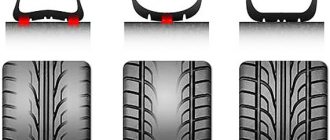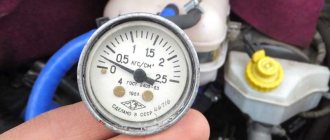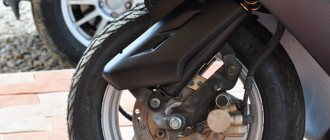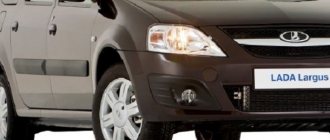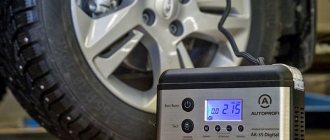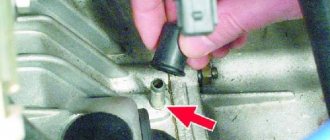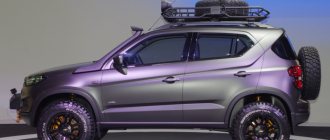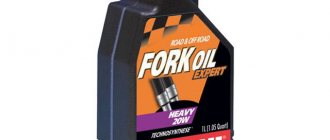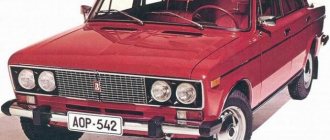What pressure should be in motorcycle tires? How to determine it correctly
To determine what pressure should be in the wheels of a motorcycle, moped, scooter, or sportbike, let’s consider the factors that it influences:
With cold pressure, everything is relatively simple - it makes sense to stick to the values recommended by the motorcycle manufacturer. Manufacturers are jealous of the performance characteristics and quality of their products. Thorough bench and sea tests carried out by them guarantee the selection of the most balanced indicators, which are indicated in the accompanying documentation.
For convenience, a reminder sign is usually placed on the arm of the pendulum. The parameters depend on the brand of motorcycle, model, weight and can vary between 2.0-2.5 atm. for the front wheel, 2.2-2.9 atm. for – rear.
Hot pressure depends on many factors related to the riding style of a particular rider. The best values that provide the required ride quality must be selected individually and empirically. This can be done in several steps:
Important! The “hot” pressure in the rear wheel tire should not exceed the figures recommended by the manufacturer.
This way you will determine the best settings for your riding style.
After the motorcycle cools down, the air pressure in the tires will drop, and the next time you start driving, you may feel some discomfort for the first 3-5 minutes. It will seem to you that the wheels are underinflated, there is excessive traction, controllability suffers, and the motorcycle is swaying. But at the end of this time interval, the wheels will warm up, the pressure in them will rise, the contact patch will acquire the necessary shape, and movement will become comfortable.
Important! When driving with a passenger, the pressure in the rear tire is increased by 0.2 atm.
How to measure blood pressure correctly
The indicator must be monitored, especially if any problems are noticed in driving the vehicle. But even without this, it needs to be measured. The procedure is carried out monthly using a special device - a pressure gauge, which can be an extension of the pump or a separate device. The sequence of its execution looks like this:
- the pressure gauge readings are reset to zero;
- remove the cap from the wheel nipple;
- attach the device to it;
- lightly press the nipple to release air from the tire;
- evaluate the indicator after the pressure gauge needle stops.
When taking measurements, you need to take into account an error of approximately 0.2 atm. And for accuracy, carry out the manipulation before leaving, when the tires are cold. Due to its heating during movement, the amount of air inside increases.
What pressure should be in the tires of a car depends on many circumstances. But if the wheels wear unevenly, mainly along the edges, in the middle, or in spots, this is already evidence of an incorrectly chosen value of the indicator. After correcting the situation, not only will the tires last longer, but the ride itself will become more comfortable.
What is the effect of tire pressure when used incorrectly?
The incorrectness of tire inflation when riding a motorcycle cannot be underestimated. In addition to technical problems, it poses a threat to traffic safety and the rider himself. At the same time, excessive and insufficient pressure in the tires of a motorcycle, moped, or sports bike lead to different consequences.
Overpressure
When pumping tires, the following effects occur:
Insufficient pressure
Too poorly inflated wheels bring their own troubles:
Short-term riding on underinflated tires using special devices - towing devices - is allowed for motocross motorcycles when performing stunts and driving off-road. But driving such equipment on ordinary roads is prohibited, so non-professionals should not take risks.
Important!
Tire pressure
Timely checking the tire pressure of your car guarantees a high level of safety while driving. This need is due to the hypersensitivity of modern tubeless tires, due to which every hole, curb or speed bump on the road is a serious obstacle that reduces the pressure inside the tires. Since many car enthusiasts are accustomed to determining the pressure in a car’s tires by immodestly kicking the wheel, they are unlikely to be able to determine the exact indicators in this way. This is where all the problems arise, because a significant decrease in pressure can cause a lot of trouble, even leading to emergency situations. With optimal tire pressure, the driver can fully feel not only the comfort of driving, but also confidence in his own safety.
How to measure and how to measure tire pressure
To maintain the correct pressure in motorcycle tires, you need to know in what units and what devices it is measured.
Any self-respecting motorbike enthusiast should always take a compressor and a pressure gauge on the road - this is the same device that measures pressure. Pressure gauges are mechanical - pointer and rack and pinion - as well as electronic of various modifications.
The main requirement for a pressure gauge is accuracy. Control of the best pressure depends on it. The error of a low-quality device can reach up to 0.5 atm and cause many problems. Therefore, you need to approach the purchase of a good pressure gauge responsibly; you should not save in this matter.
The basic unit of measurement for tire pressure in Russia is the Atmosphere (1 atm. = 1 kgf/sq. cm), which is almost the same in value as the Bar (1 bar. = 0.98 atm.). Foreign manufacturers often use Psi (1 psi = 1 psi) and Kilopascal. All units are easily converted into each other using formulas or special tables:
So, when choosing the correct pressure in motorcycle tires, you must proceed from your own experience and riding style. The time spent selecting the correct values will pay off in saved financial resources and your own safety. In addition, any deviation from the norm, while improving some indicators, inevitably worsens others.
Source
How to choose the correct tire pressure?
The front and rear tires must have different pressures, and this is important to understand before picking up a pump. The user manual of any bike always indicates the optimal pressure for cold tires, so if you measure the indicators immediately after a ride, do not be surprised that the pressure gauge will show different values - the air inside has warmed up and expanded.
The manufacturer indicates all parameters for cold tire inflation on a table on the motorcycle frame or in the user manual. They vary depending on the type of motorcycle, but, as a rule, the data varies between 2.0-2.5 Atm for the front wheel and 2.2-2.9 Atm for the rear. If you plan to put another person on the bike, we recommend inflating the tires by 0.2 atm.
Hot pressure depends on many factors, including the rider’s riding style, so they will have to be selected individually for each specific case:
To begin, inflate the tires to 2-2.3 Atm, taking into account that for the rear tire the pressure should always be 0.3 Atm more than for the front.
Ride at your normal pace for 10-15 minutes. The pressure in the rear and front tires should increase by an average of 0.2 atm.
Then use the pressure gauge again: if it shows a value within the normal range of cold pressure, then you have achieved your goal. If it is higher, then lower the wheels; if lower, pump up the tires. Measure the tire pressure and adjust the amount of air inside until you achieve the result.
If you notice that immediately after the start you feel a little discomfort, then this is in the order of things. The rubber needs to warm up a little and in five minutes everything will return to normal.
Dependence of indicators on climate in summer and winter
Manufacturers of tires and vehicles do not regulate changes in tire pressure depending on the season. But such a need still arises. Especially where the quality of roads is poor. It also matters whether the car has cargo, passengers, or just the driver.
These factors influence what tire pressure should be in the summer, thus:
- for a lightly loaded car (with one or two passengers), the optimal value is 1.9 atmospheres with tires of common diameters R13-R16;
- if all the seats in it are occupied, and there is also luggage, it is better to inflate the front wheels to 2-2.1 atmospheres, and the rear wheels to 2.3;
- on an uneven road, it makes sense to lower them by 5-10% of normal so as not to get tired of shaking.
Measuring tire pressure with a digital pressure gauge
It is even more important to calculate what tire pressure should be in winter. At this time of year the road can become slippery and snowy. And leaving a warm garage box in the cold leads to a decrease in the indicator. However, in the cold season, it is better to slightly overinflate the tires, no more than 10-15% of normal. This will help increase the stability of the car and make it easier to control.
More on AutoLex.Net:
Popular options for how to paint wheels yourself
With reduced tire pressure, the braking distance is shortened, which also contributes to safety. It also affects the suspension - driving on broken, frozen asphalt becomes more comfortable due to reduced shaking.
What will be the consequences of under/excess pressure in motorcycle tires?
If you overinflate your tires, get ready for the contact patch to decrease, and along with it, the grip characteristics will deteriorate, the ride will become much harsher, there is a possibility of vibration, and the load on the suspension will also increase significantly. Riding in overinflated tires on a wet road is quite dangerous, since due to the small contact zone, the motorcycle will begin to skid when turning and brake poorly. The most unpleasant consequence will be a deterioration in strength and wear resistance. A motorcycle tire can even explode when driving on hot asphalt - one pebble can ruin everything.
Increased tire pressure is used only in two cases: if there is another passenger on the motorcycle or during long high-speed rides.
Underinflated tires have their own list of problems: their contact patch may be larger, but due to its irregular shape it wears out and deforms extremely quickly. Among the useful qualities of rubber, handling, maneuverability, directional stability and fuel consumption are seriously affected. Eventually, if you don't correct the pressure in your motorcycle tires, you will end up with cord separation. If your motorcycle has wheels with tubed tires, then insufficient inflation of the tubes will sooner or later lead to accidental dismounting.
Riding on underinflated tires is practiced only on special enduro sports motorcycles for performing off-road stunts.
However, in order to safely drive a motorcycle, it is not enough to simply set the correct tire pressure and leave it at that - we also recommend that you refer to the speed index table.
Source
What should be the tire pressure for a sports motorcycle?
Dear motorcycle friends, always check the tire pressure after a long period of inactivity! Especially when they contain tourniquets (adhesive rubber bands for repairing punctures). How the wheel is inflated will determine indicators such as: fuel consumption, braking distance, acceleration dynamics, maneuverability and, of course, tire wear. IF THE TIRE PRESSURE ON A SPORTS MOTORCYCLE DOES NOT MEET FACTORY REQUIREMENTS, THERE IS A RISK OF DAMAGE TO THE WHEELS ON THE ROAD SURFACE, SINCE THIS RUBBER IS LOW PROFILE!
On a sports motorcycle with a volume of 600 and 1000 cc. The pressure in the front tire should be 2.5, in the rear 2.9 atmospheres. For heavy road motorcycles such as XJR 1300, CB 1300, the requirements are similar
Requirements for specific sports motorcycle models
✔︎ Honda • CBR 1000 • CBR 600 • CB 600 Hornet • CB 900 • CBR 1100 XX Blackbird • CB 1300 • CB 1000 • CB 1100 • CBF 1000 • CBF 600 • VFR 800 • VTR1000
✔︎ Suzuki • GSF 1200 • GSF 1250 • GSX-R 1000 • GSX-R 600 • GSX 1300 Hayabusa • SV 1000 • SV 600 • GSR 600 • GSR 750
✔︎ Yamaha • FJR1300 • FZ1 • FZ6 • FZ8 • FZS 1000 • MT-07 • MT-09 • XJ6 • XJR1300 • YZF-R1 • YZF-R6
✔︎ Kawasaki • ER-6F (Ninja 650R) • ER-6N • GTR1400 • Ninja 650 • Versys 1000 • Versys 650 • Z 1000 • Z 1000SX • Z 650 • Z 750 • ZX-10 Ninja • ZX-6 Ninja • ZZR 1100 • ZZR 1400
Motorcycle tire pressure
What does the handling of a motorcycle depend on?
Of course, it depends on the suspension and the condition of the tires, and even on how they are inflated. This is an important aspect and we’ll talk about it a little. By the way, there are a lot of myths and misconceptions on this subject, some of which, in part, were created by motorcycle manufacturers.
What does tire pressure affect?
1. Contact patch (the area of contact between the tire and the road), the larger the contact patch, the better the motorcycle’s grip on the asphalt. 2. Suspension operation, the lower the pressure in a motorcycle tire, the lower the requirements for the suspension 3. Handling, the higher the tire pressure, the more controllable the motorcycle, taking into account a sufficient contact patch and sufficiently good suspension performance
Let’s not get into details and theory, but let’s talk more simply.
Cold and hot pressure
Air is pumped into the tire; as the rubber and rim warm up, the air heats up, its volume increases and this leads to an increase in pressure in the tire. If you take two identical tires, put them on two identical motorcycles, pump the same pressure into the rear and front tires and give the motorcycles to two different riders, then after 20 minutes of riding in normal mode, each rider will have their own pressure in the rear and front tires. We also take into account that everyone has their own method and driving habit, and this also affects the temperature in the tires. Weather conditions, asphalt temperature, and rubber composition make their own adjustments, so the important indicator is not the cold pressure, but the hot pressure, and this pressure is selected individually.
What if the wheel is overinflated?
If you inflated a tire when it was cold and warmed it up while driving in the city, the pressure in it will increase on average by 0.2-0.5 atmospheres. If you already have high pressure when cold, then as you drive in the city you will further reduce the contact patch of the tire with the asphalt. The smaller the contact patch, the worse the grip. One day in hot weather, you can open up as usual - and... break the rear wheel, or brake in a turn as usual - and break the front wheel. Overinflated tires also affect suspension settings. The higher the tire pressure, the softer the suspension should be. Thus, if your tire has excess pressure when it’s cold, then as the tire warms up, not only does the contact patch decrease, but also the performance of the suspension worsens, which, in total, can lead to unexpected results. If you feel as if after a long ride the grip of your motorcycle tires on the asphalt is deteriorating, now you know why this happens.
Like with an underinflated wheel
If the tire pressure is too low, then even after the wheel has warmed up, you will feel as if you have completely loosened the suspension - both the rear and front will absorb and rock the motorcycle, and the motorcycle's handling will decrease. You will feel a lack of control when cornering, the rear tire will spring under you, unload, and lose traction with the asphalt. In short, the rear will behave inappropriately, wobble, etc.
Normally inflated wheel
Feels a little underinflated for the first 3-5 minutes of riding, then the hesitation and wobble of the bike stops and you are left with a tire with optimal contact heel and optimal shock absorption capabilities. And boldly move forward!….
Difference in tire pressure when cold
The rear wheel warms up more than the front, even in city conditions. So, in the city, we recommend inflating the front by 0.1, 0.05 atmospheres more than the rear. Remember - after warming up, the pressure in the front and rear tires should be the same, and when cold, they should differ by 0.1, 0.05 atmospheres (the front is inflated more than the rear).
How to quickly adjust pressure
The pressure in the rear tire when hot should not exceed 2.2 ATM. Recommended pressure is 2 ATM when hot. After your usual mileage - stop - immediately, without letting the tire cool down - measure the pressure in the rear tire - if it exceeds 2.2 ATM - deflate it to 2.2 ATM. Do the same with the front. Now, when driving in cold weather, you will feel some discomfort for 3-5 minutes. Don’t open up too much, after 500 meters you will feel improvements and after 2-3 kilometers you will feel the old comfortable sensations returning. In return for this slight discomfort, you will receive an increase in the contact patch, optimal suspension performance and, in general, significantly more confidence when opening and braking.
Lying pressure gauges
Most dial pressure gauges made in China have a monstrous error. It can reach 0.8 ATM. We recommend that you always rely on accurate pressure gauge readings. Digital pressure gauges generally have less accuracy. You may often hear strange pressure recommendations, keep in mind that your opponent's pressure gauge may differ significantly from the actual pressure or pressure shown by your gauge.
What pressure to pump in enduro tires
I wouldn't reduce it. It will catch on something hard and turn it around.
I always go 0.8-1. But my power is 10/2^0.5
Thank you. I will download one and a half)))
Why then does the manual talk about 1 atmosphere?
I meant, more, that is, thicker, that is, there is more air volume there. In theory, a motorcycle wheel should be between a car and a bicycle. that is, in the region of 3 atmospheres. and according to the manual it is supposed to be less than one atmosphere.
Where is it? On the sticker on the pendulum 1.5.
No direct comparison, too different masses, volumes and wheel designs. On my bike, by the way, in a tubeless tube it’s approx. 1.5 atm (and not only for me).
So I found the topic that I needed. I had the front wheel re-shoeed by motorcycle mechanics, they told me to pump it to 1.8-2 atmospheres. The manual says 1.5 (for an Australian).
I'm confused. There is a towing brake on the rear, I asked to pump it up to 1.5.
For driving on asphalt and relatively hard soils it is still necessary.
I'll take a look at my pendulum...
This is the first time I've come across this approach. Why is there less in the rear than in the front?
It’s not two times different, it just coincided. There is no front-to-back relationship in terms of values.
This is the first time I've come across this approach. Why is there less in the rear than in the front?
On a bicycle it’s the other way around, because your front one always has normal grip on the surface. On a motorcycle, you are always accelerating, and the grip of the front is insufficient, but the rear is always in contact with the ground and bears the bulk of the load.
The volume of the tire itself is larger, the contact area is larger, which means you can pump less pressure, and the danger of a puncture to the rim is much less. minimum 0.6, maximum for me is comfortable around 1.2-1.3. the pressure is adjusted to suit the intended road. if you don’t know where and it’s far away, then more; if along familiar paths, where you know everything, you can do less.
Well, don’t forget that if an inflated wheel reaches an oak tree in the air and meets a log that you are jumping over, and even without bark, and even after a rain, and even if at an angle, then it will tear off enchantingly, and you will fly you will be beautiful. the same goes for roots and other ruts and ditches on the road.
and in general, the pressure and others like it should be selected for a specific tire, road, and the pattern itself is very important. the fact that the backside should only row and nothing more is a delusion, they say, don’t care, let it move left and right. it must withstand lateral loads well, and if anything happens, the failure must be controlled and predictable.
Theory and practice
We all know that when air is heated, it expands, and when it cools, it occupies less volume. In order to determine what pressure a motorcycle tire should be, it is necessary to clearly determine how the vehicle will be used. Two identical tires, after active driving, may show different pressures, which is associated with warming up the air. Braking, asphalt temperature, and dynamic friction of the tire surface heat up the front and rear wheels differently.
To determine what motorcycle tire pressure is necessary for efficient and safe riding, you can use the following rules:
The tire pressure on a Minsk motorcycle may not match the pressure on sports or motocross bikes. For example, the average for motorcycles weighing up to 150 kg (without a pilot) should be: 2-2.2 ATM in the front wheel, 2.4-2.6 in the rear .
If you load your work motorcycle and move with a passenger, then the pressure can be increased to 2.6-2.9 Atm. On average, the correction per passenger should be about 0.2 Atm. Conversely, the pressure in the tires of a motocross motorcycle should be reduced when entering the track before active riding.
Correctly set pressure will not only reduce fuel consumption and extend their service life, but will also dramatically increase the controllability of the motorcycle at high speeds, when turning or overtaking.
Optimal pressure
And yet, before inflating the tires, it is worth looking at the car manufacturers’ recommendations regarding the value of the indicator. They may differ not only depending on congestion and road characteristics, but also tire size, speed, and type of tire.
In low profile car tires
Many vehicle owners prefer to put them in low-profile tires, which improve maneuverability and maintain vehicle controllability. This is especially important on bad roads.
What pressure should be in low-profile tires depends on their width, the ratio of the cross-section to it, as well as the diameter of the rim. If the profile is 55, the indicator should be looked up in the table:
| Width-diameter | Pressure (atm.) |
| 155-14 | 2,2 |
| 165-14 | 2,2 |
| 165-15 | 2,1 |
| 185-15 | 2,1 |
| 195-15 | 2,1 |
| 205-16 | 2,2 |
| 215-16 | 2,2 |
| 215-17 | 2,1 |
| 225-17 | 2,1 |
For profile 50 the values are different:
| Width-diameter | Pressure (atm.) |
| 165-15 | 2,4 |
| 195-15 | 2,4 |
| 205-15 | 2,3 |
| 225-15 | 2,3 |
| 195-16 | 2,4 |
| 205-16 | 2,3 |
| 215-16 | 2,3 |
| 225-16 | 2,3 |
| 205-17 | 2,4 |
| 215-17 | 2,4 |
| 225-17 | 2,4 |
| 225-18 | 2,5 |
| 235-18 | 2,5 |
If profile 45 the indicator increases:
| Width-diameter | Pressure (atm.) |
| 165-15 | 2,5 |
| 195-15 | 2,6 |
| 195-16 | 2,5 |
| 205-16 | 2,4 |
| 205-17 | 2,7 |
| 215-17 | 2,6 |
| 225-17 | 2,5 |
| 235-17 | 2,4 |
| 215-18 | 2,4 |
| 225-18 | 2,4 |
| 235-18 | 2,6 |
| 245-18 | 2,5 |
| 255-18 | 2,8 |
| 225-19 | 2,8 |
| 245-19 | 2,7 |
| 295-19 | 2,8 |
| 265-20 | 2,8 |
For profile 40, on average it should be even higher:
| Width-diameter | Pressure (atm.) |
| 195-17 | 2,8 |
| 205-17 | 2,8 |
| 215-17 | 2,7 |
| 235-17 | 2,6 |
| 245-17 | 2,5 |
| 255-17 | 2,5 |
| 215-18 | 2,8 |
| 225-18 | 2,7 |
| 235-18 | 2,6 |
| 245-18 | 2,6 |
| 265-18 | 2,6 |
| 275-18 | 2,8 |
| 225-19 | 2,8 |
| 245-19 | 2,9 |
| 255-19 | 2,9 |
| 275-19 | 2,9 |
| 245-20 | 2,9 |
| 295-20 | 2,9 |
If the profile is 35, the indicator is chosen as follows:
| Width-diameter | Pressure (atm.) |
| 215-18 | 2,8 |
| 225-18 | 2,8 |
| 255-18 | 2,7 |
| 265-18 | 2,6 |
| 275-18 | 2,5 |
| 215-19 | 2,8 |
| 225-19 | 2,8 |
| 235-19 | 2,8 |
| 245-19 | 2,8 |
| 255-19 | 2,8 |
| 265-19 | 2,9 |
| 275-19 | 2,8 |
| 245-20 | 2,9 |
| 255-20 | 2,9 |
| 275-20 | 2,9 |
With profile 30 it should be as follows:
| Width-diameter | Pressure (atm.) |
| 265-19 | 2,8 |
| 275-19 | 2,8 |
| 285-19 | 2,8 |
| 245-20 | 2,9 |
| 275-20 | 2,9 |
| 285-20 | 2,9 |
| 245-22 | 2,9 |
| 265-22 | 2,9 |
| 285-22 | 2,9 |
More on AutoLex.Net:
Everything in detail about the car brake system, the structure of the brake system, the principle of operation
With profile 25 there are only 2 types of tires. And for both, normal pressure is 2.9.
For cars with large wheels
What pressure should be in the tires depends not only on the profile features, but also on the size of the wheel. In addition to the most common R13 and R14, there are also R15 and R16. For the last two, the optimal indicator is:
- when the car is half loaded - 2 atm.;
- at full – 2.2.
If the bulk of the cargo is in the trunk, the pressure in the rear wheels needs to be increased by another 0.2.
For motorcycle
What pressure should be in the motorcycle tires is usually also indicated on the equipment itself. If the wheels are R-17, then for the rear the indicator is 2.9 with a width of 180, for the front with the designation 120 - 2.5. But the driver can experimentally find out that with such values the motorcycle does not listen well.
Then the tires need to be inflated more strongly if the vehicle is subject to a large load (if there is a passenger or the driver is heavy). On average, the indicator should be increased by 0.2 atm.
And if you plan to drive at high speed on a good road, the wheels should be lowered. In such cases, 2.1 atm is sufficient. for the front and 2 for the rear.
Watch this video on how to choose the right tire pressure:
Insufficient tire pressure
Depending on the degree of pressure reduction, the motorcycle may “float,” sway, and decrease dynamics. The most dangerous effect is jumping on a weak rear tire, as a result of which you can completely lose control of the car. Rubber wear increases sharply, speed decreases.
Cross-country motorcycles can use these effects to obtain an additional source of extreme sports or when performing various stunts or when riding off-road, however, low pressure in the tires of a Honda sports class motorcycle or other manufacturers can lead to dire consequences, including tire rupture, skidding, spinning body vibration .
Possible problems with incorrect tire pressure
Tire pressure affects the following parameters:
- Area of contact with the road surface. The larger the contact patch, the higher the level of grip.
- On the performance of the suspension system, the lower the pressure, the fewer questions there are to the suspension.
- The higher the indicator, the better the controllability.
- Increased vibrations, vehicle instability.
It is worth considering that the safety of driving your motorcycle also depends on the tire pressure.
Overpressure
If you exceeded the pressure before you started moving, keep in mind that after half an hour of movement it will still increase. On average, the rate increases by half an atmosphere, depending on weather conditions. In this case, the tires bend, the area of contact with the road decreases, vibration and load on the suspension system increases. Because of this, at elevated temperatures when cornering, the motorcycle may skid and skid when braking.
Insufficient pressure
When the performance decreases, the motorcycle may sway, become uncontrollable and there is a deterioration in dynamics. It should be noted that jumping is very dangerous if the pressure in the rear tire is low, in which case you can completely lose control. The tires wear out quickly and the car produces less speed. If the tire pressure is low when driving, the tires can be damaged, the motorcycle will begin to vibrate and skid when cornering.
Practical recommendations
To quickly set the tire pressure, you should use the rule - the pressure in the rear tire should not exceed 2.1-2.2 Atm. Pump up 2 atm in a cold state, then drive for 10-15 minutes in your usual mode on the road. Then, measure the pressure; if it exceeds 2.2 Atm, lower it; if not, pump it up. As a result of this step-by-step procedure, optimal pressure can be achieved.
A common mistake made by inexperienced bikers is overinflating the tire due to the fact that when starting to move, the pilot feels discomfort and excess tire grip. If everything is done correctly, the discomfort should go away after the air in the tire warms up. You should also not rely on the indicators of pressure gauges; sometimes inexpensive devices get knocked down and debris gets into them. In fact, on some pressure gauges the error can reach up to 0.5-0.8 Atm, which is a lot.
In addition to the level of tire inflation, it is important to pay attention to other characteristics of the wheels.
| Speed index | Maximum speed, km/h |
| A | 40 |
| B | 50 |
| C | 60 |
| D | 65 |
| E | 70 |
| F | 80 |
| G | 90 |
| J | 100 |
| K | 110 |
| L | 120 |
| M | 130 |
| N | 140 |
| P | 150 |
| Q | 160 |
| R | 170 |
| S | 180 |
| T | 190 |
| U | 200 |
| H | 210 |
| V | 240 |
| W | 270 |
| Y | 300 |
| VR | >210 |
| ZR | >240 |
| (W) | >270 |
| Z | >300 |
For example, the correct tire pressure for a Kawasaki motorcycle must also correspond to the tire speed index chart. In order to save money and due to lack of awareness, motorcycle owners can install low-index tires on motorcycles capable of accelerating to a speed of 240-280 km/h, which is strictly prohibited and can lead to tragic consequences.
How to choose the right tires for your motorcycle
Now you know approximately what types of tires are produced. What else is important when choosing tires? Of course, their quality. Motor rubber is a very important part of motorcycles, so it must be abrasion-resistant and the most wear-resistant. Tires can be soft or hard. Soft ones grip the road well. Hard – wear-resistant. But all manufacturers are trying to ensure that these qualities are combined in all their tires.
Many motorcyclists prefer wide models. This choice may not always be correct. Here you need to take into account the distance that is between the wings and suspensions. An increased tire size will worsen the handling of motor vehicles. And it will be unsafe to drive on such tires.
To increase wear life, pay special attention to tire inflation. Low tire pressure will cause tire wear to occur very quickly. And of course, the service life of any tires also depends on your driving style.
Table 1. Explanation of the load index.
| Load Index = Speed Limit | |
| Letter | KM. |
| J | 100 |
| K | 110 |
| L | 120 |
| M | 130 |
| N | 140 |
| P | 150 |
| Q | 160 |
| R | 170 |
| S | 180 |
| T | 190 |
| U | 200 |
| H | 210 |
| V220 | 220 |
| V230 | 230 |
| V or V240 | 240 |
| V250 | 250 |
| V260 | 260 |
| W or V270 | 270 |
| V280 | 280 |
| V290 | 290 |
| Y or V300 | 300 |
| Z | more than 240 |
Motorcycle tire size
Table 2. Dimensions for all motorcycle tire marking systems.
| Acceptable value, rim width | Metric | Alpha | Standard in inches | Low profile in inches |
| 1.60, 1.85 | 70 | MG | 2.75 | – |
| 1.60, 1.85 | 80 | M.H. | 3.00 | 3.60 |
| 1.85, 2.15 | 90 | MJ | 3.25 | 3.60 |
| 1.85, 2.15 | 90 | M.L. | 3.50 | 4.10 |
| 2.15, 2.50 | 100 | MM | 3.75 | 4.10 |
| 2.15, 2.50, 2.75 | 110 | MN | 4.00 | 4.60 |
| 2.15, 2.50, 2.75 | 110 | MP | 4.25 | 4.25/85 |
| 2.15, 2.50, 2.75 | 120 | M.R. | 4.50 | 4.25/85 |
| 2.15, 2.50, 2.75 | 120 | MS | 4.75 | 5.10 |
| 2.50, 2.75, 3.00 | 130 | M.T. | 5.00 | 5.10 |
| 2.75, 3.00, 3.50 | 140 | M.U. | 5.50 | – |
| 3.50, 4.00 | 150 | MV | 6.00 | – |
| 4.00, 4.50 | 160 | – | 6.25 | – |
